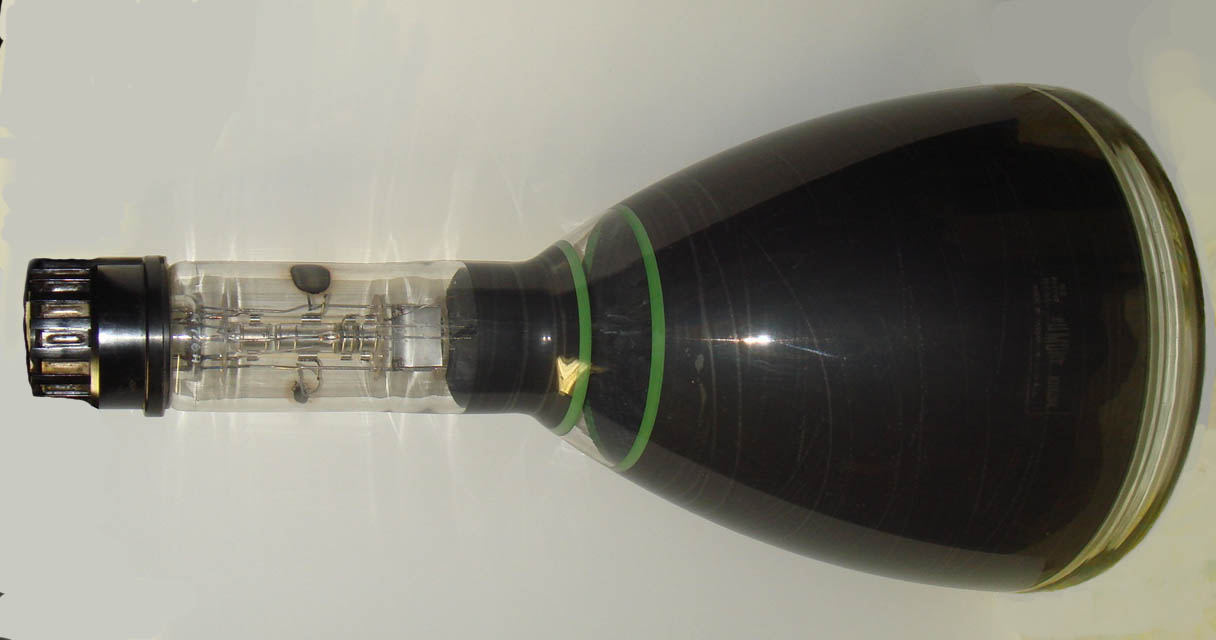|
|
1934 5" PrototypeThis CRT is dated 1/22/34. The tube was damaged at the base at some point and lost vacuum. Probably was used to experiment with magnetic deflection. |
Picture Tubes
Pre War Experimental and Prototype Picture Tubes
|
|
1934 5" PrototypeThis CRT is dated 1/22/34. The tube was damaged at the base at some point and lost vacuum. Probably was used to experiment with magnetic deflection. |
|
|
Very simple gun structure, only 4 connections. |
|
|
1934 9" PrototypeThis CRT is dated 3/26/34. Possibly another test tube for magnetic deflection systems. This tube appears to still be under vacuum. |
|
|
The gun structure is the same as the 5" tube above. |
|
|
C-739 9" Experimental CRTThis tube has one set of deflection plates, it was used in the 1933 test sets. This test set was an improvement over the 1932 set, as it was designed to use one tuning system for video and sound, unlike the previous set which used two separate receivers. Also the 1933 set was designed for 240 lines vs. the 120/180 lines for the 1932 set. This tube used magnetic deflection for the vertical sweep and electrostatic deflection for the horizontal sweep. At this time in television development there were no power tubes available that could supply the current required to drive the magnetic deflection field at the frequencies required. This tube appears to be still under vacuum. This CRT is dated 10/20/36, probably when it was put in storage vault. |
|
|
|
Connections to the horizontal deflection plates on the neck of the tube. |
|
|
C-745D 5" Experimental CRTThis tube was developed for the RR-366 field test set. See picture below. Unfortunately this tube has gone to air, apparently from a bad seal as there are no cracks or any other obvious faults. |
|
|
Marketing cut sheet of the RR-366 chassis and picture tube. |
Pre War Production Picture Tubes
|
|
5BP4 (1802-P4)
This CRT was used in many of
the prewar 5" televisions, RCA TT-5 &
TRK-5, Meissner
10-1153, GE HM171 & HM185.
It is a very poor performing tube, even a NOS tube will have
a very dim display.
|
|
|
9AP4 (1804-P4)
This CRT was used in the
prewar RCA TRK-9/90.
|
|
|
This
particular 9AP4 came from the RCA archives in Camden. The
label carries numerous identification numbers. The L-2041
may have referenced an inventory or project, C-730P is the
sequential number that was given to developmental CRT's by
RCA, 1804-P4 is the commercial designation. Then the date
which appears to be Jan 11,1939, the initials I have
no idea, last is "South Vault" possibly where the tube was
stored.
|
|
|
12AP4 (1803-P4)
This CRT was used in RCA
TRK-12,
Andrea
2F12, and virtually all
prewar 12" mirror in lid televisions.
|
|
|
This is the 12AP4 in its protective cardboard cover, the tube was shipped this way. When it was installed in the television the front cover was removed and the cone section was kept with the tube, notice the cutout for the HV lead. |
 |
K1003P4
This CRT is used in DuMont
prewar sets as a replacement for the prewar 14AP4 and
144-9-T CRT's.
|
Post War Production Picture Tubes
|
|
3KP4
This CRT is used in the Pilot
TV-37, the first set sold
for under $100.
|
|
|
3NP4 (MW6-2)
Projection CRT used in
Protelgram projection units. The Protelgram was used by many
manufacturers,
Emerson,
Decca, Scott. The face of
the CRT is spherical to match the curvature of the mirror
that was used in the Protelgram. A version of this tube with
a flat face (MW6-4) was also produced that was used with a
direct lens projection system.
|
|
|
5TP4
Projection CRT used in all
RCA projection sets and
most other
projection televisions from
1946 - 1949. Anode voltage 25KV.
|
|
|
5AZP4
Second generation projection
CRT, replaced the 5TP4 in projection sets through the mid
50's. Due to the 40KV anode voltage this tube used, the high
voltage lead was molded on to the tube.
|
|
|
7DP4
This CRT was primarily used
in the RCA
621 set.
|
|
|
7EP4
This CRT is used in early 7"
sets, in particular the
Transvision kits.
|
|
|
7JP4
This CRT is used in virtually
all 7" sets from 1948 until the early 50's.
|
|
|
8BP4
This CRT is electrically
identical to the 7JP4 except for the screen size.
|
|
|
10HP4
This CRT is also electrically
identical to the 7JP4 except that the screen is a full 10"
diameter. Raytheon built this tube for use in their console.
|
|
|
10BP4
This CRT is the most commonly
used picture tube, used in virtually every 10" set from
after the war until the early 50's.
|
|
|
10FP4
This CRT is the aluminized
version of the 10BP4, used primarily by
GE and
Farnsworth as original
equipment.
|
|
|
12LP4/12KP4
Like the 10BP4 above this is the
most common 12" CRT found in late 40's and early 50's
televisions. The 12KP4 is the aluminized version of the
12LP4
|
|
|
15AP4 (First Style)
This CRT was used in early
production DuMont sets. Notice the "bump" between the neck
and the main bulb, similar to the prewar 12AP4.
|
|
|
15AP4 (Second Style)
This CRT is used in DuMont sets.
The "bump" is gone, and the form is the same as other CRT's
of the era. Notice that DuMont continued to use the "button"
style HV connector found on non television CRT's.
|